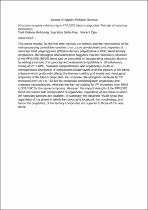 ResearchSpace
ResearchSpace
Structure–property relationship in PP/LDPE blend composites: The role of nanoclay localization
JavaScript is disabled for your browser. Some features of this site may not work without it.
- ResearchSpace
- →
- Research Publications/Outputs
- →
- Journal Articles
- →
- View Item
| dc.contributor.author |
Mofokeng, Tladi G

|
|
| dc.contributor.author |
Ray, Suprakas S

|
|
| dc.contributor.author |
Ojijo, Vincent O

|
|
| dc.date.accessioned | 2019-02-27T09:49:19Z | |
| dc.date.available | 2019-02-27T09:49:19Z | |
| dc.date.issued | 2018-01 | |
| dc.identifier.citation | Mofokeng, Ray, S.S. and Ojijo, Vincent O. 2018. Structure–property relationship in PP/LDPE blend composites: The role of nanoclay localization. Journal of Applied Polymer Science, vol 135, https://doi.org/10.1002/app.46193. | en_US |
| dc.identifier.issn | 0021-8995 | |
| dc.identifier.uri | https://onlinelibrary.wiley.com/doi/abs/10.1002/app.46193 | |
| dc.identifier.uri | http://hdl.handle.net/10204/10735 | |
| dc.description | Copyright: 2018 Wiley. Due to copyright restrictions, the attached PDF file only contains the abstract of the full text item. For access to the full text item, kindly consult the publisher's website. | en_US |
| dc.description.abstract | This article reports, for the first time, on how the kinetics and thermodynamics of the melt-processing control the nano/micro-structure development and properties of nanoclay-filled polypropylene (PP)/low-density polyethylene (LDPE) blend ternary composites. Morphological characterization suggests that the nano/micro-structure of the PP/LDPE (80/20) blend can be controlled by incorporating nanoclay alone or by adding a mixture of organoclay and maleated compatibilizers. Simultaneous mixing of PP, LDPE, maleated compatibilizers, and organoclay results in homogeneous distribution of intercalated silicate layers in all the phases of the blend, a feature which profoundly affects the thermal stability and tensile and rheological properties of the blend composites. For example, the elongation-at-break for PP increases from 28.1 to 155.6% for composite containing both organoclay and maleated compatibilizers, whereas the thermal stability for PP increases from 269.8 to 303.3 °C for the same composite. However, the impact strength of the PP/LDPE blend decreases with incorporation of organoclay, regardless of the phase in which the nanoclay particles are localized. In summary, the obtained results show that regardless of the phase in which the nanoclay is localized, the morphology, and hence the properties, of the ternary composites are superior to those of the neat blend. | en_US |
| dc.language.iso | en | en_US |
| dc.publisher | Wiley | en_US |
| dc.relation.ispartofseries | Worklist;21492 | |
| dc.subject | Blends | en_US |
| dc.subject | Mechanical properties | en_US |
| dc.subject | Nanoclay | en_US |
| dc.subject | Rheology | en_US |
| dc.title | Structure–property relationship in PP/LDPE blend composites: The role of nanoclay localization | en_US |
| dc.type | Article | en_US |
| dc.identifier.apacitation | Mofokeng, T. G., Ray, S. S., & Ojijo, V. O. (2018). Structure–property relationship in PP/LDPE blend composites: The role of nanoclay localization. http://hdl.handle.net/10204/10735 | en_ZA |
| dc.identifier.chicagocitation | Mofokeng, Tladi G, Suprakas S Ray, and Vincent O Ojijo "Structure–property relationship in PP/LDPE blend composites: The role of nanoclay localization." (2018) http://hdl.handle.net/10204/10735 | en_ZA |
| dc.identifier.vancouvercitation | Mofokeng TG, Ray SS, Ojijo VO. Structure–property relationship in PP/LDPE blend composites: The role of nanoclay localization. 2018; http://hdl.handle.net/10204/10735. | en_ZA |
| dc.identifier.ris | TY - Article AU - Mofokeng, Tladi G AU - Ray, Suprakas S AU - Ojijo, Vincent O AB - This article reports, for the first time, on how the kinetics and thermodynamics of the melt-processing control the nano/micro-structure development and properties of nanoclay-filled polypropylene (PP)/low-density polyethylene (LDPE) blend ternary composites. Morphological characterization suggests that the nano/micro-structure of the PP/LDPE (80/20) blend can be controlled by incorporating nanoclay alone or by adding a mixture of organoclay and maleated compatibilizers. Simultaneous mixing of PP, LDPE, maleated compatibilizers, and organoclay results in homogeneous distribution of intercalated silicate layers in all the phases of the blend, a feature which profoundly affects the thermal stability and tensile and rheological properties of the blend composites. For example, the elongation-at-break for PP increases from 28.1 to 155.6% for composite containing both organoclay and maleated compatibilizers, whereas the thermal stability for PP increases from 269.8 to 303.3 °C for the same composite. However, the impact strength of the PP/LDPE blend decreases with incorporation of organoclay, regardless of the phase in which the nanoclay particles are localized. In summary, the obtained results show that regardless of the phase in which the nanoclay is localized, the morphology, and hence the properties, of the ternary composites are superior to those of the neat blend. DA - 2018-01 DB - ResearchSpace DP - CSIR KW - Blends KW - Mechanical properties KW - Nanoclay KW - Rheology LK - https://researchspace.csir.co.za PY - 2018 SM - 0021-8995 T1 - Structure–property relationship in PP/LDPE blend composites: The role of nanoclay localization TI - Structure–property relationship in PP/LDPE blend composites: The role of nanoclay localization UR - http://hdl.handle.net/10204/10735 ER - | en_ZA |





